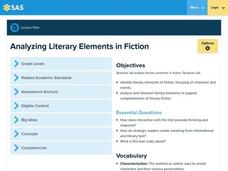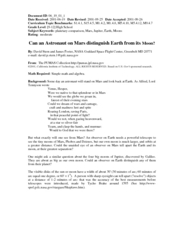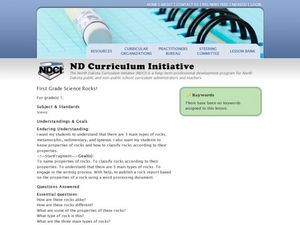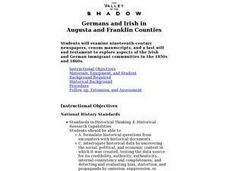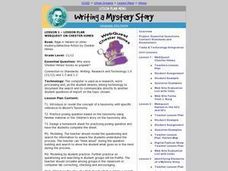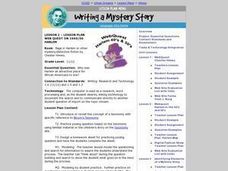Curated OER
Writing Equations of Parabolas in Vertex Form
Pupils use their knowledge of the vertex form of a quadratic equation to graph parabolas using a graphing calculator, given a specific move to make. this lesson may be used as a review or as extra practice, in groups or individually.
Curated OER
The Robot Archaeologist
Students discover what is needed to program an underwater robot to complete a course of action. In this robot archaeologist lesson students design an archaeological strategy of an underwater vehicle.
Curated OER
Suffrage Strategies: Voices for Votes
Students discuss the history and importance of voting. In this voting lesson, students research the women's suffrage movement and the methods used to change people's beliefs about suffrage for women. Students also create posters to...
Pennsylvania Department of Education
Analyzing Literary Elements in Fiction
Learners analyze the characters and events in fictional writing. In this literary elements lesson, students study the meaning of the words characterization and fiction. They listen to the story Pigsty by Mark Teague, or any other book...
Curated OER
Can an Astronaut on Mars Distinguish Earth from its Moon?
Students explore the possibility of being on Mars and being able to identify the Earth. In this space lesson plan students complete a set of calculations to see if this is possible.
Curated OER
WET Science Lesson #3: Comparison of Aquatic and Terrestrial Plants
Elementary life science explorers compare and contrast aquatic and terrestrial plants (elodea and soybeans) in a Venn diagram. Some background information is provided to support direct instruction, and general instructions are provided...
Curated OER
Cowboys in the 1890s
Students study the rise of cattle ranching in the West and the economic conditions under which cowboys worked in the 19th century. They examine the economic changes that affected cowboys in the 1890s. They analyze the effects of the...
Curated OER
Indian Resistance
Students observe the pictures and maps of the Sequoyah Indians. In this Sequoyah lesson plan, students use the maps and pictures to discuss observations and write responses of the Indian point of view.
Curated OER
Little House in the Census: Almanzo and Laura Ingalls Wilder
Learners view copies of the 1880 and 1900 censuses and then create and conduct their own census of their homes, comparing all three.
Curated OER
Anti-Vietnam War Movement Lesson
Students examine reasons why many Americans opposed the Vietnam War. In this world history instructional activity, students view a Powerpoint of anti-war images and a timeline of events that led to the war. Students examine speeches made...
Curated OER
Shall We Go Dutch?
Students examine the language and cultural differences that were encountered by the Indians and the Dutch leading to disaster for the first European settlement in Delaware.
Curated OER
Using Picture Mapping to Improve Student Comprehension
Students draw pictoral representations of a reading selection they read in order to recall information. In this picture mapping lesson plan, students use pictures to comprehend what they read and sequence the pictures as well.
Curated OER
Literal Equations
Students explore Literal Equations. In this literal equations lesson, students use the Internet to connect to links and solve linear equations. Students investigate, analyze and record their findings on various activity worksheets.
Curated OER
Design Your Own Biological Experiment
Students work together to research a topic of interest to them. They form hypothesis and complete experiments testing them. They present their findings to the class.
Curated OER
First Grade Science Rocks!
First graders examine rocks. In this rock lesson, 1st graders look at the properties of rocks and classify them. They discover the three types of rocks: sedimentary, metamorphic, and igneous.
Curated OER
Germans and Irish in Augusta and Franklin Counties
Students examine 19th century newspapers, a last and testament, and census manuscripts to analyze the Irish and German immigrant communities in the 1850s and 1860s. They write a letter from the perspective of an Irish or German immigrant.
Curated OER
Finding Ourselves: The Search for American Identity
Students examine American identity through race, ethnicity, class, gender, regionalism, political values, and beliefs focusing on the Depression era.
Curated OER
Tom Sawyer
Young scholars compare and analyze the relationship between Mark Twain's background and what they believe to be true about the book Tom Sawyer.
They apply correct sentence and paragraph construction in their writing.
Curated OER
Interesting Beginnings: An Autobiographical Sketch
Students discuss the characteristics of an autobiography. Individually, they complete a graphic organizer and a timeline of events about their life. In groups, students brainstorm ideas for an interesting sentence and write an...
Curated OER
Seeking Civil Rights
Students explore the impact of the Plessy v. Ferguson case. In this social justice lesson, students examine the case, Jim Crow laws, and non-violent forms of protest. Students write essays to persuade the government regarding unjust laws.
Curated OER
Campaign 2000
Students research newspapers and the Internet to learn about the election. Students work in groups and choose a state that they want to compare to Florida. Students organize the data they have found into a graph labeling an "x" and "y"...
Curated OER
United States Entry into World War I: Some Hypotheses About U.S. Entry
High schoolers take a stand on a hypothesis for U.S. entry into World War I, supported by specific evidence.
Curated OER
WebQuest on Chester Himes
Students perform a WebQuest to find out why Chester Hime's detective books were so popular. Small groups perform the research together then report to the class.
Curated OER
WebQuest on 1940/1950 Harlem
Students perform a WebQuest to fin out why Harlem was an attractive place for African Americans to live. Small groups perform the research together, and report to the class.



